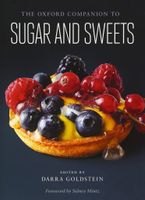Advertisement
Transforming the Fantastic into the Real
Published 2015
Through culinary artistry and the names they give their confections, sweet makers establish a territory of fertile imagination, seduction, and invention. Each edible creature broadens reality, expands the realm of fiction, and embodies the past in the present. The artisans combine the old and the modern, paying tribute to both canonical tradition and heresy, to the local and the universal, to the system of language, to the realm of chance and creativity, and to necessity and survival.
Some historical examples in Spain include animas del purgatorio (souls in purgatory), a version of floating island for which meringues are set onto custard cream colored red with beet juice, and orejones (big ears), a favorite seventeenth-century delicacy that consisted of peaches modeled to resemble ears and then air-dried. The contemporary orejas or orelletes found throughout Spain are very thin, delicate fried sweets in the shape of ears.


